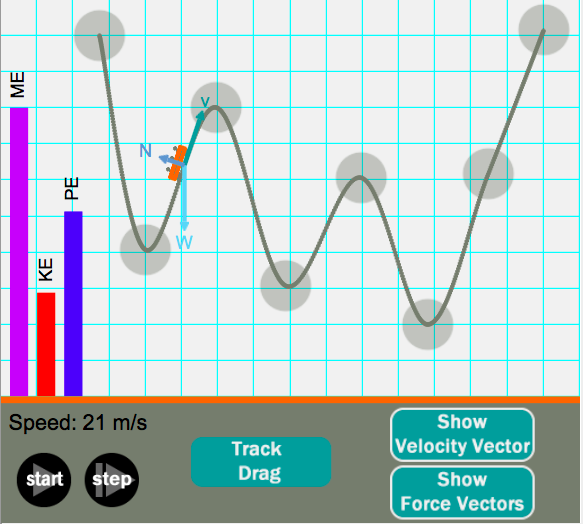 Roller Coaster Energy
Roller Coaster Energy
Resource:
Physics Interactives: Roller Coaster Model
Roller Coasters and Energy - Student Exercise
Grade Level: High School
Description:
This simulation-based activity focuses on energy on a roller coaster as it animates the motion of a coaster car along pre-made or learner-created track designs. Energy bar charts are displayed to show changes in kinetic, potential, and total mechanical energy. The pre-made tracks include ramp, loop, or hill configurations. The companion Student Exercise asks students to make claims about specific track designs and support their ideas with data from the model.
Performance Expectation:
Energy (HS-PS3-1): Create a computational model to calculate the change in the energy of one component in a system when the change in energy of the other component(s) and energy flows in and out of the system are known.
This activity aligns with the three dimensions of the Next Generation Science Standards in the manner described below:
| Conservation of Energy and Energy Transfer (HS-PS3.B.2): Energy cannot be created or destroyed, but it can be transported from one place to another or transferred between systems. |
This DCI is specifically addressed by using either the pre-made or user-designed track configurations. Build the track, run the model, and view energy bar charts that simultaneously show kinetic energy, potential energy, and total mechanical energy. Students can clearly see that energy is not “lost” in the roller coaster system, but is conserved as it changes from kinetic-to-potential and vice versa. This idea is further reinforced by the companion Student Exercise (Questions 2-6 about kinetic/potential energy). Run the model without friction and you’ll see that total mechanical energy does not change. |
| Systems and System Models: Models (e.g., physical, mathematical, computer models) can be used to simulate systems and interactions – including energy, matter, and information flows – within and between systems at different scales. |
and its companion exercise are appropriate for two levels – beginner and more advanced learner. Run the model without friction and watch as the energy bar charts depict changing kinetic and potential energy, while total mechanical energy remains constant. But add friction (Track Drag button) and the model becomes more complex. By introducing friction (a dissipative force) the motion on the track will be affected by drag on the cart and total mechanical energy will become lesser as motion energy is converted to thermal energy. |
| Energy and Matter: Energy cannot be created or destroyed – it only moves between one place and another place, between objects and/or fields, or between systems. |
The model and its companion exercise were specifically developed to help students see that energy is conserved. This is accomplished by showing the roller coaster as an ideal system without friction. The energy bar charts clearly show that as kinetic energy goes up, potential energy goes down in the same amount. Without friction, total mechanical energy is conserved and does not change. To ramp up the learning, students can add friction to their roller coaster track and observe the total mechanical energy go down. Is it lost? No – it is dissipated into the environment and converted into thermal energy. |
| Engaging in Argument from Evidence: Construct an oral or written argument or counter-arguments based on data and evidence. |
Question #7 of the Student Exercise challenges students to make and defend a written claim about how specific track configurations affect speed of the roller coaster cart. Question #8 asks them to use scientific reasoning and data from the model to explain how changing the height of the track at certain points affects speed. |
| Developing and Using Models: Develop or use a model based on evidence to illustrate the relationships between systems or between components of a system. |
The Roller Coaster Interactive provides a robust environment to explore numerous components of n energy model. For instance, students explore the connection between increasing potential energy and decreasing kinetic energy (and vice versa), the role of height in affecting this energy transformation, and the role of friction in dissipating energy from the system. |
Associated Reading from The Physics Classroom
Other Supporting Pages at The Physics Classroom:
View Infographic.
(Coming Soon)
Search the NGSS Corner
Maybe you're looking for something really specific that pertains to a desired topic and emphasizes one or more of the listed NGSS dimensions. Why not try a search of this section of our website? Simply select from one or more of the pull-down menus and click Search This page will reload and a collection of possibilities will be displayed in this section of the page and sorted by relevancy.